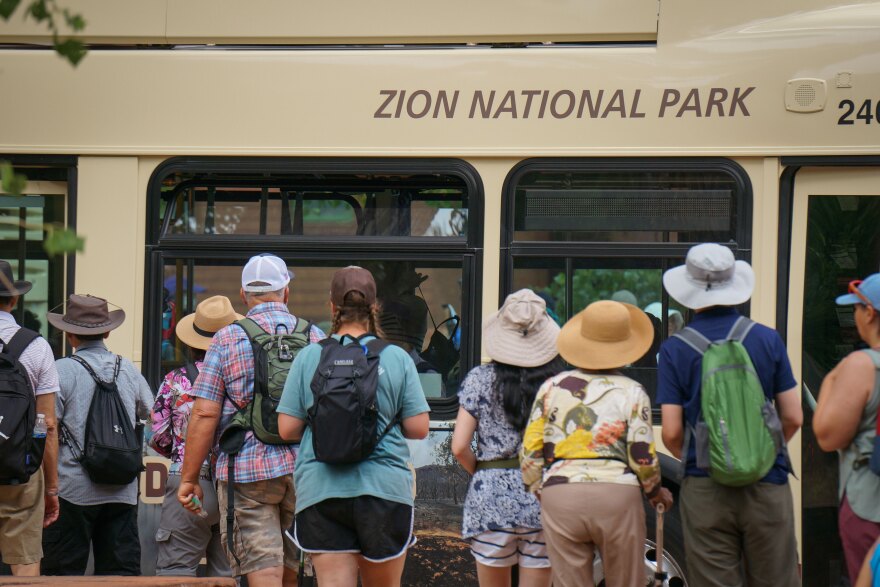The price tag may go up for international travelers hoping for a glimpse of Utah’s Mighty Five.
An early July executive order from President Donald Trump directed the National Park Service to increase entry fees for foreign visitors. Although it’s unclear what the new surcharge would be or when it may go into effect, the move targets a vital piece of Utah’s economic pie.
“The National Parks are a huge, huge draw for international visitors,” said Ali Harford, assistant marketing director at the Moab Office of Tourism. “International travel is a really big part of what we do at the tourism office, and it's really important to us.”
These travelers spent more than $776 million in Utah in 2023, the most recent year in the Utah Office of Tourism’s database. The top countries were Canada ($193.2 million), France ($72.9 million) and Germany ($60.8 million).
The president’s trade policies and rhetoric have already pushed Canadian tourism and travel to the U.S. down this year. That could be significant in Utah, as the northern neighbor accounted for 28% of international arrivals, according to a Kem C. Gardner Policy Institute analysis.
The influx of tourism money has helped fuel a boom for hotels, shops and restaurants in gateway communities. In 2023, Zion National Park’s 4.6 million visitors spent $676 million at businesses near St. George, according to National Park Service data. The 1.5 million people who visited Arches National Park that year spent $283 million in surrounding towns.
Moab companies that cater to tourists have come to depend on European travelers, Harford said, especially in the summer. That’s because fewer Americans choose to go to the desert during the hottest months, and visitors from abroad help fill that gap.
But even if an international surcharge arrives, she’s not too worried.
“People are coming for a month. They expect these trips to be a little bit expensive,” Harford said. “I really don't see a world where a European would be like, ‘Now that this is another X amount of dollars, I'm not going to go.’ Because these are bucket list trips.”
Attracting overseas tourists has become such a big business that the Greater Zion Convention and Tourism Office in St. George has a team dedicated to international marketing, said Government Affairs Director Heath Hansen.
He agreed that a new fee probably wouldn’t keep foreign tourists away — as long as it’s not too steep.
“Increasing fees on international travelers who don't pay regular taxes here in the U.S. to support the park system — it probably could make some sense,” he said. “Of course, it's all going to be about the details.”
And the executive order doesn’t offer much in the way of those.
One bill introduced in the U.S. Senate to codify the order doesn’t specify a set fee hike, either. It leaves the amount up to local park administrators.
A recent analysis from the Property and Environment Research Center suggested that adding a $100 surcharge for international travelers at Yellowstone National Park would decrease total visitation by 57,000 but increase total revenues by $55.2 million.
If money earned from the higher fees were to be directed back to the parks, it could potentially help with the backlog of infrastructure projects that have built up as visitation skyrocketed in recent years. The park service estimates that parks nationwide would need $22.9 billion to complete all their necessary maintenance and repairs.
The big concern, Hansen said, would be that raising fees too much, too quickly, could sour some overseas visitors on making Utah parks part of their itinerary.
“We understand the need to raise revenue for the park service,” Hansen said. “But if you're going to get to the point where you're pricing people out, then you're going to hit a point of diminishing returns.”
There would also be logistical hurdles. As Hansen understands it, the parks don’t currently track whether visitors are U.S. citizens or international travelers. So in order to charge some of them more, park staff would need to figure out a way to check their status.
Ultimately, the cost of seeing Utah’s red rock wonderland may not be the top worry on foreign travelers’ minds.
On a recent visit to an international tourism conference, Harford said the expense of national parks didn’t come up during her discussions with tour operators from other countries.
The bigger concern was uneasiness about coming to the U.S. at all. That’s because of the general political climate and headlines about tariffs and visitors being detained at airports.
“We heard from travel agents that that was making people nervous, or just a little bit more hesitant than they've been before,” she said. “But we're very conscious of that, too, and working with them to ensure people that they're welcome here, and Moab really wants them.”






